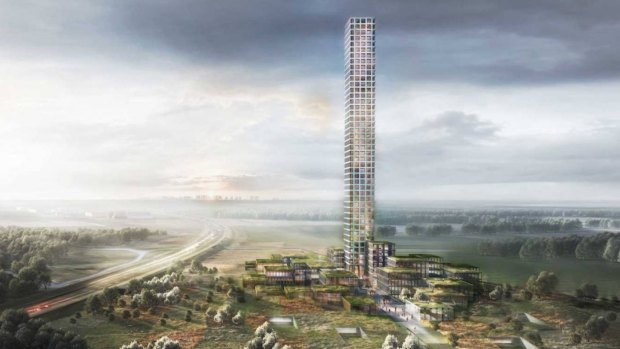This was published 5 years ago
Europe's 'Eye of Sauron': Denmark wants to build Western Europe's tallest skyscraper in a tiny town of 7,000
By Rick Noack

An artist's impression of the tower, which will be 320 metres high.
It's April 1, so there's a reason not to believe everything you see or hear.
But even though the headline that Denmark is trying to construct Western Europe's tallest building in a tiny town of 7,000 people may sound like an April Fools' joke, it really isn't one. Promise.
The plans go back years and Brande's municipal council approved them in mid-March, paving the way for Western Europe's soon-to-be tallest skyscraper. With a height of 320 metres, the rural office building will dwarf London's Shard tower and will be roughly the same height as the Eiffel Tower in Paris.
"It will undoubtedly be of the greatest significance for the city of Brande, but I do not doubt it will affect the whole of Central Jutland," Ib Lauritsen, the mayor of Ikast-Brande, told Danish broadcaster DR.
In a town that has so far mostly been known as a "railway town" because of its train station, Western Europe's tallest skyscraper might indeed raise some eyebrows. Denmark's flat landscape will make the tower visible from about 64 kilometres away.
The plans aren't the outcome of a local mayor's ambitious imagination, but rather the result of clothing company Bestseller's international success story, following its foundation in Brande in the 1970s. Mostly known for brands such as Jack & Jones and Vero Moda, the company is planning to use the skyscraper as its new headquarters, complete with restaurants and shops, the Guardian newspaper reports.
About 274 kilometres away, in Denmark's capital Copenhagen, residents won't be able to see the rural tower once it's supposed to be completed in 2023. But being dwarfed by a town of 7,000 has triggered a somewhat emotional response in this city of 600,000, which recently approved plans for its own high-rises that would also reach far into European skies - just not as far as Brande's "Eye of Sauron," as critics on social media are calling it.
In Brande, residents have mostly responded with a shoulder shrug to such capital city jealousy.
What has sparked local pride among some is being seen as craziness by others, which sums up the reactions rural skyscrapers have triggered across the world, wherever they have popped up.
Democratic Denmark appears to be somewhat of an outlier in the global quest for the domination of the rural skies. Researchers with the University of Oslo who have studied this phenomenon concluded last year that skyscrapers built in predominantly rural societies are often a sign of wastefulness and even authoritarianism. While the researchers concluded that "skyscrapers are more likely to be socially productive investments in, for instance, wealthy and highly urbanised societies than in poor and largely rural," they nevertheless found evidence that tall buildings were booming in the latter, too.
"Harsh dictatorships seem equally eager to build skyscrapers independent of whether they preside over rural or urban societies," the researchers wrote. To dictators and authoritarian rulers, skyscrapers are symbols of status and prestige - no matter if constructing them makes economic sense.
Random high-rises in the middle of farmland can also be a sign of less sinister motives, as Japan's property bubble in the 1990s showed. Long after the artificial inflation of real estate prices had come to an end in the early 1990s, an investor opened a 41-story high-rise building on the rural outskirts of the small city of Kaminoyama. It took years until the owners found residents willing to move into Japan's own version of the "Eye of Sauron."
Prestige and over-calculation may similarly be the driving force behind Europe's rural skyscrapers, which explains a degree of skepticism of such projects. In 2015, a Swiss investor announced his plans to construct the world's tallest hotel skyscraper in a remote Alpine village, making global headlines. His plans appear to have faltered amid tax evasion accusations and a prolonged search for a safe location to construct the building.
The skyscraper was supposed to be completed in 2019, but instead of construction trucks the 1,000 inhabitant village of Vals are still listening to cow bells.
Sometimes, pride comes before a skyscraper's fall.
The Washington Post
See also: China's new 'horizontal skyscraper' is nearly complete
See also: 'Manhattan's mini-city': New York's incredible new $35b tourist attraction opens
Sign up for the Traveller newsletter
The latest travel news, tips and inspiration delivered to your inbox. Sign up now.